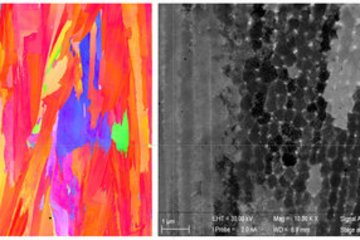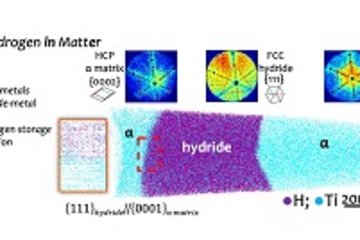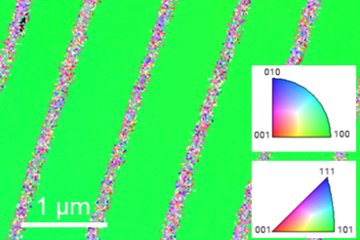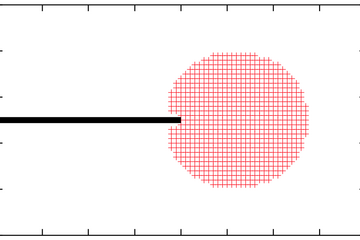All genres
21.
Journal Article
Segregation-Induced Nanofaceting Transition at an Asymmetric Tilt Grain Boundary in Copper. Physical Review Letters 121 (25), 255502 (2018)
22.
Journal Article
In-situ atomic-scale observation of oxidation and decomposition processes in nanocrystalline alloys. Nature Communications 9, 946, pp. 1 - 9 (2018)
23.
Journal Article
In–situ TEM study of diffusion kinetics and electron irradiation effects on the Cr phase separation of a nanocrystalline Cu–4 at.% Cr thin film alloy. Journal of Alloys and Compounds 695, pp. 1583 - 1590 (2017)
24.
Journal Article
Kinetics and crystallization path of a Fe-based metallic glass alloy. Acta Materialia 127, pp. 341 - 350 (2017)
25.
Journal Article
Atom probe tomography of intermetallic phases and interfaces formed in dissimilar joining between Al alloys and steel. Materials Characterization 120, pp. 268 - 272 (2016)
26.
Journal Article
Self-Assembled Monolayers: Star-Shaped Crystallographic Cracking of Localized Nanoporous Defects (Adv. Mater. 33/2015). Advanced Materials 27 (33), p. 4947 - 4947 (2015)
27.
Journal Article
Star-Shaped Crystallographic Cracking of Localized Nanoporous Defects. Advanced Materials 27, pp. 4877 - 4882 (2015)
28.
Journal Article
Microstructure refinement for high modulus in-situ metal matrix composite steels via controlled solidification of the system Fe-TiB2. Acta Materialia 96, pp. 47 - 56 (2015)
29.
Journal Article
The nucleation of Mo-rich Laves phase particles adjacent to M23C6 micrograin boundary carbides in 12% Cr tempered martensite ferritic steels. Acta Materialia 90, pp. 94 - 104 (2015)
30.
Journal Article
Glass-formation and corrosion properties of Fe–Cr–Mo–C–B glassy ribbons with low Cr content. Journal of Alloys and Compounds 615 (S1), pp. S128 - S131 (2014)
31.
Journal Article
Multi-element-resolved electrochemical corrosion analysis. Part I. Dissolution behavior and passivity of amorphous Fe50 Cr15 Mo14 C15 B6. Corrosion Science 89, pp. 59 - 68 (2014)
32.
Journal Article
Role of Nb in glass formation of Fe–Cr–Mo–C–B–Nb BMGs. Journal of Alloys and Compounds 604, pp. 157 - 163 (2014)
33.
Journal Article
Crystallization, phase evolution and corrosion of Fe-based metallic glasses: an atomic-scale structural and chemical characterization study. Acta Materialia 71, pp. 20 - 30 (2014)
34.
Journal Article
Structural and functional characterization of enamel pigmentation in shrews. Journal of Structural Biology 186 (1), pp. 38 - 48 (2014)
35.
Journal Article
Element-Resolved Corrosion Analysis of Stainless-Type Glass-Forming Steels. Science 341 (6144), pp. 372 - 376 (2013)
36.
Journal Article
Polyamorphic transitions in Ce-based metallic glasses by synchrotron radiation. Physical Review B 84 (22), 224116 (2011)
37.
Conference Paper
Alloy design and processing routes for novel high modulus steels. In: PTM 2015 - Proceedings of the International Conference on Solid-Solid Phase Transformations in Inorganic Materials 2015, p. 981 (Eds. Chen, L.-Q.; Militzer, M.; Botton, G.; Howe, J.; Sinclair, C. W. et al.). International Conference on Solid-Solid Phase Transformations in Inorganic Materials 2015, PTM 2015, Whistler, BC, Canada, June 28, 2015 - July 03, 2015. PTM 2015, Whistler, British Columbia (2015)
38.
Conference Paper
Acoustic properties of metallic glasses in the mesoscopic regime by inelastic X-ray scattering. 17th International Symposium on Metastable, Amorphous and Nanostructured Materials (ISMANAM 2010), Zurich, Switzerland, July 04, 2010 - July 09, 2010. Journal of Alloys and Compounds 509 (SUPPL. 1), pp. S95 - S98 (2011)
39.
Talk
Resolving grain boundary complexions in Copper by STEM and analyzing their impact on properties. Workshop Advanced Electron Microscopy in Materials Research, La Clusaz, France (2023)
40.
Talk
Impact of Hydrogen on Dislocation Nucleation and Strength in bcc Fe–Cr alloys. TMS 2022 Annual Meeting, Symposium “Mechanical Behavior at the Nanoscale VI”, Anaheim, CA, USA (2022)









